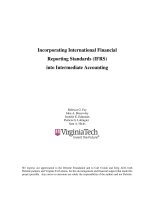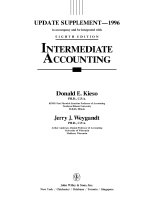Intermediate Accounting - Chap002 pdf
Bạn đang xem bản rút gọn của tài liệu. Xem và tải ngay bản đầy đủ của tài liệu tại đây (1.01 MB, 89 trang )
Copyright © 2007 by The McGraw-Hill Companies, Inc. All rights reserved.
Review of the
Accounting
Process
2
Insert Book Cover
Picture
2-2
The Basic Model
Economic events cause
changes in the financial
position of a company.
External events
involve an exchange
between the company
and another entity.
Internal events do not
involve an exchange
transaction but do
affect the company’s
financial position.
2-3
Learning Objectives
Analyze routine economic events—
transactions—and record their effects on a
company’s financial position using the
accounting equation format.
2-4
The Accounting Equation
A = L + OE
- Owner Withdrawals+ Owner Investments
- Expenses
- Losses
+ Revenue
+ Gains
2-5
Accounting Equation for a Corporation
A = L + SE
+ Retained Earnings+ Paid-in Capital
- Expenses
- Losses
+ Revenues
+ Gains
- Dividends
2-6
Account Relationships
Debits and credits affect the Balance Sheet
Model as follows:
Debits and credits affect the Balance Sheet
Model as follows:
A = L + PIC + RE
Assets
Dr.
+
Cr.
-
Liabilities
Dr.
-
Cr.
+
Paid-in
Capital
Dr.
-
Cr.
+
Retained
Earnings
Dr.
-
Cr.
+
Revenues
and Gains
Dr.
-
Cr.
+
Expenses
and Losses
Dr.
+
Cr.
-
2-7
Account Relationships
A = L + PIC + RE + R + G- E - L
Permanent accounts
represent the basic
financial position
elements of the
accounting equation.
Temporary accounts
keep track of the
changes in the
retained earnings
component of
shareholders’ equity.
Debits and credits affect the Balance Sheet
Model as follows:
Debits and credits affect the Balance Sheet
Model as follows:
2-8
Source
documents
Record in
Journal
Financial
Statements
Transaction
Analysis
Post to
Ledger
Unadjusted
Trial Balance
Record & Post
Adjusting
Entries
Adjusted
Trial Balance
Close Temporary
Accounts
Post-Closing
Trial Balance
The
Accounting
Processing
Cycle
2-9
Learning Objectives
Record transactions using the general journal
format.
2-10
Accounting Processing Cycle
On January 1, 2007, $40,000 was borrowed
from a bank and a note payable was signed.
Prepare the journal entry.
Two accounts are affected:
Cash (an asset) increases by $40,000.
Notes Payable (a liability) increases by $40,000.
Account numbers are
references for posting to
the General Ledger.
2-11
General Ledger
The “T” account is a shorthand used by
accountants to analyze transactions. It
is not
part of the bookkeeping system.
2-12
Learning Objectives
Post the effects of journal entries to T-accounts
and prepare an unadjusted trial balance.
2-13
Posting Journal Entries
On July 1, 2006, the owners invest $60,000 in a new
business, Dress Right Clothing Corporation.
GENERAL JOURNAL
Page 1
Date Description
Post.
Ref.
Debit Credit
July 1 Cash 60,000
Common Stock 60,000
Post the debit portion of the entry to the Cash ledger account.
Post the debit portion of the entry to the Cash ledger account.
2-14
Posting Journal Entries
1
2-15
Posting Journal Entries
2 3
2-16
Posting Journal Entries
4
5
2-17
6
Posting Journal Entries
2-18
Posting Journal Entries
Post the credit portion of the entry to the Common Stock ledger
account.
Post the credit portion of the entry to the Common Stock ledger
account.
1
2-19
Posting Journal Entries
2
3
2-20
Posting Journal Entries
4
5
2-21
6
Posting Journal Entries
2-22
After recording all entries for the period, Dress
Right’s Trial Balance would be as follows:
After recording all entries for the period, Dress
Right’s Trial Balance would be as follows:
Debits = Credits
A Trial
Balance is a
listing of all
accounts
and their
balances at
a point in
time.
A Trial
Balance is a
listing of all
accounts
and their
balances at
a point in
time.
2-23
Additional Consideration
Perpetual
Inventory
System
Inventory account is
continually updated to
reflect purchases and sales.
Cost of goods sold account
is continually updated to
reflect sales.
Periodic
Inventory
System
Purchases account
reflects purchases of
inventory.
Cost of goods sold and
inventory are adjusted at
period end.
Discussed in
more depth in
Chapters 8 & 9.
2-24
Adjusting Entries
At the end of the period,
some transactions or
events remain
unrecorded.
Because of this, several
accounts in the ledger
need adjustments
before their balances
appear in the financial
statements.
2-25
Learning Objectives
Identify and describe the different types of
adjusting journal entries.
Determine the required adjustments, record
adjusting journal entries in general journal
format, and prepare an adjusted trial balance.









